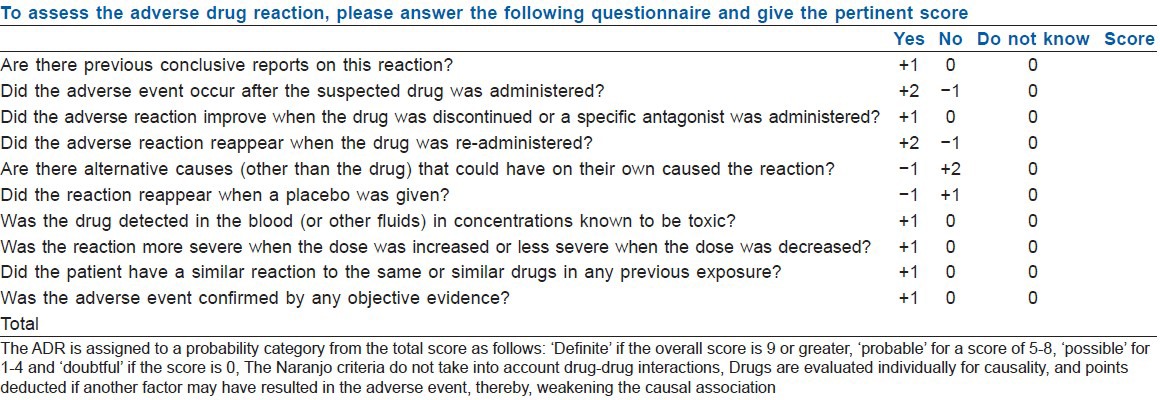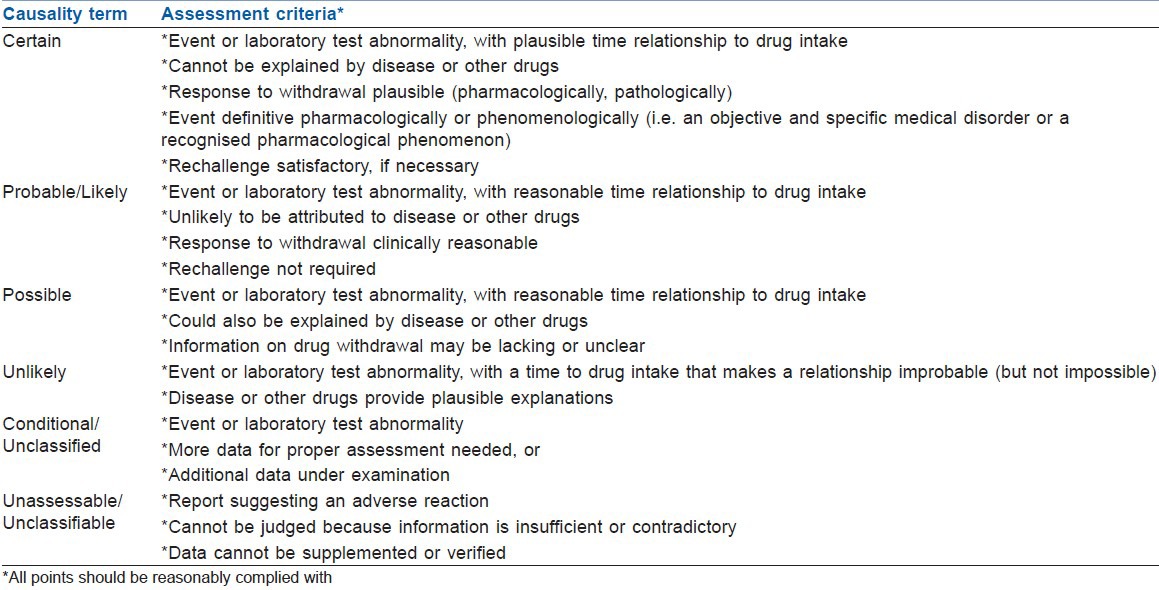Sir,
I have read with interest the articles of Chowdhry et al., and Tripathy et al., on adverse reactions to various drugs published in IJA.[1,2] I would like to address certain issues related to reporting of adverse drug reactions (ADR).
ADRs caused by immune and non-immune mechanisms are a major cause of morbidity and mortality worldwide. Hence, it is important to identify ADRs and to demonstrate a causal relationship between the drug and the untoward clinical event. Causality assessment is used to determine the likelihood that a drug caused a suspected ADR. There are a number of methods used to judge causation. Each has pros and cons associated with its use and most require some level of expert judgement to apply. The causality assessment systems put forth by the World Health Organisation Collaborating Centre for International Drug Monitoring, the Uppsala Monitoring Centre (WHO-UMC), the Naranjo Probability Scale and the Venulet algorithm are the generally accepted and most widely used methods for causality assessment in clinical practice as they are simple to apply.[3,4,5] The WHO-UMC Causality Assessment System and the Naranjo Probability Scale offer objective, reliable and valid causality assessment of ADRs along with the convenience of being easy to apply methods. Table 1 depicts the “Naranjo Probability Scale,” which may be helpful for assessing unexpected ADRs and useful for evaluators with little experience.[4] The WHO-UMC causality system is basically a combined assessment, taking into account the clinical-pharmacological aspects of the case history and the quality of documentation of observation, while prior knowledge of the ADR plays a less significant part. Table 2 shows the WHO-UMC Causality Assessment System.[3]
Table 1.
The Naranjo adverse drug reaction probability scale[4]

Table 2.
WHO-UMC causality categories[3]

For each of these methods, the quality of data and documentation influence the reliability of the method. Moreover, individual systems of causality assessment have, in some instances, found to be non-comparable.[6] In fact, Agbabiaka et al.,[7] conclude that there is still no method universally accepted for causality assessment of ADRs. Thus, validating an ADR report needs to take into consideration which causality assessment technique was employed.
Anaesthesiologists can be encouraged to use assessment based on either of the above two scales while reviewing articles related to ADRs.
REFERENCES
- 1.Chowdhry V, Debasish G, Dharmajivan S. Anaphylaxis to vecuronium: A rare event. Indian J Anaesth. 2012;56:314–5. doi: 10.4103/0019-5049.98799. [DOI] [PMC free article] [PubMed] [Google Scholar]
- 2.Tripathy S, Nair PV. Adverse drug reaction, patent blue V dye and anaesthesia. Indian J Anaesth. 2012;56:563–6. doi: 10.4103/0019-5049.104576. [DOI] [PMC free article] [PubMed] [Google Scholar]
- 3.The use of the WHO-UMC system for standardised case causality assessment. [Last accessed on 2012 Dec 16]. Available from: http://www.WHO-UMC.org/graphics/4409.pdf .
- 4.Naranjo CA, Busto U, Sellers EM, Sandor P, Ruiz I, Roberts EA, et al. A method for estimating the probability of adverse drug reactions. Clin Pharmacol Ther. 1981;30:239–45. doi: 10.1038/clpt.1981.154. [DOI] [PubMed] [Google Scholar]
- 5.Venulet J, Ciucci AG, Berneker GC. Updating of a method for causality assessment of adverse drug reactions. Int J Clin Pharmacol Ther Toxicol. 1986;24:559–68. [PubMed] [Google Scholar]
- 6.Tiberio López G, Hueto Pérez de Heredia J, Moreno Baquedano M, García de Lucas L, Sánchez Alvarez J, Nagore Indurain C, et al. Adverse drug reactions: Naranjo's and Venulet's algorithms. Rev Clin Esp. 1992;191:270–3. [PubMed] [Google Scholar]
- 7.Agbabiaka TB, Savović J, Ernst E. Methods for causality assessment of adverse drug reactions: A systematic review. Drug Saf. 2008;31:21–37. doi: 10.2165/00002018-200831010-00003. [DOI] [PubMed] [Google Scholar]


